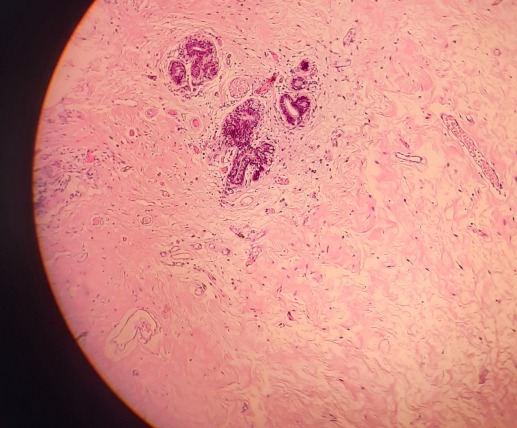Extract of Teak Leaf Buds (Tectona grandis) as Natural Dyes Replacement of Eosin on HE Staining
Keywords:
Anthocyanin, Teak Leaf, Eosin, HEAbstract
Hematoxylin and Eosin (HE) staining is a routine method in histopathology. In HE staining, eosin functions to stain the cytoplasm of the tissue. Continuous use of eosin may cause health problems due to its carcinogenic properties, thus requiring an alternative. One such alternative is teak leaf buds, which contain anthocyanin compounds. The aim of this study was to determine whether teak leaf bud extract can be used as a substitute for eosin in HE staining. The type of research used was a true experimental study with a post-test only control group design. The samples consisted of paraffin blocks, from which 10 slides were prepared: one control and nine treatment slides, with three repetitions for each concentration (20%, 30%, and 40%). Microscopic observations of HE staining using eosin showed a score of 3 (100%). Using 20% teak bud extract resulted in a score of 2 (100%), 30% concentration gave a score of 2 (33,3%) and score 3 (66,7%), while 40% concentration resulted in score 3 (100%). Kruskal-Wallis test showed eosin and teak leaf bud extract were not significantly different: for 20% concentration, p=0,083; for 30%, p=0,564; and for 40%, p=1,000 (p>0,05), indicating no significant difference.It can be concluded that 40% teak leaf bud extract is the best concentration and has the potential to replace eosin in HE staining. Future research is suggested to use 40% teak leaf bud extract with variations in staining time to further explore its potential as a substitute for eosin in histological staining.
References
br Kembaren, R., Putriliniar, S., Maulana, N. N., Yulianto, K., Ikono, R., Rochman, N. T., & Mardliyati, E. (2014). Ekstraksi dan Karakterisasi Serbuk Nano Pigmen dari Daun Tanaman Jati (Tectona grandis linn. F). Jurnal Kimia Dan Kemasan, 36(1), 191-196.
Fathinatullabibah, F., Khasanah, L. U., & Kawiji, K. (2014). Stabilitas Antosianin Ekstrak Daun Jati (Tectona grandis) terhadap Perlakuan pH dan Suhu. Jurnal Aplikasi Teknologi Pangan, 3(2), 60-63.
Khristian, E., & Inderiati, D. (2017). Bahan Ajar Teknologi Laboratorium Medis Sitohistoteknologi. Jakarta: Pusat Pendidikan Sumber Daya Manusia Kesehatan.
Labai, D. M. (2023). Hasil Pewarnaan Sediaan Sitologi Metode Diff Quik Menggunakan Ekstrak Daun Jati (Tectona Grandis) sebagai Pengganti Eosin. Diploma thesis, Poltekkes Kemenkes Kupang. Retrieved from: http://repository.poltekeskupang.ac.id/id/eprint/4462
Mizan, M. N., Damayanti, M., & Nuroini, F. (2021). Gambaran Sitologi Epitel Mukosa Rongga Mulut Pewarnaan Ekstrak Bunga Sepatu (Hibiscus Rosa-sinensis L.). Prosiding Seminar Nasional UNIMUS, 4, 1790-1796. https://prosiding.unimus.ac.id/index.php/semnas/article/view/955
Mutoharoh, L., Santoso, S. D., & Mandasari, A. A. (2020). Pemanfaatan Ekstrak Bunga Sepatu (Hibiscus Rosa-Sinensis L.) sebagai Alternatif Pewarna Alami Sediaan Sitologi Pengganti Eosin pada Pengecatan Diff Quik. Jurnal SainHealth, 4(2), 21-26. https://doi.org/10.51804/jsh.v4i2.770.21-26
Setiawan, B. (2016). Optimalisasi Metode Automatic Slide Stainer untuk Pewarnaan Jaringan Menggunakan Haematoksilin-Eosin. Laporan Akhir Penelitian Pembinaan Bagi Tenaga Fungsional Non Dosen, Universitas Jember. Retrieved from: http://repository.unej.ac.id/handle/123456789/78632
Wulandari, F. Y. S., Widiyani, S. D., & Iswara, A. (2019). Caesar (Caesalpinia Extract): Pewarna Alami Tanaman Indonesia Pengganti Giemsa. Jurnal Labora Medika, 3(2), 45-49. https://jurnal.unimus.ac.id/index.php/jlabmed/article/view/7216

Downloads
Published
How to Cite
Issue
Section
License
Copyright (c) 2025 Laboratory Journal of Infectious Diseases

This work is licensed under a Creative Commons Attribution-ShareAlike 4.0 International License.




